

The Cooling Supplement
Chilling innovations
As cold as ice
Antifreeze in the data center
Thinking small
Cooling with nanofluids
Joule in the crown
Extracting water from air
Air or liquid cooling?
Vertiv™ CoolPhase Flex delivers both in one hybrid solution. Start with air and switch to liquid anytime. Compact, e icient, and scalable on demand.
Embrace a hybrid future.
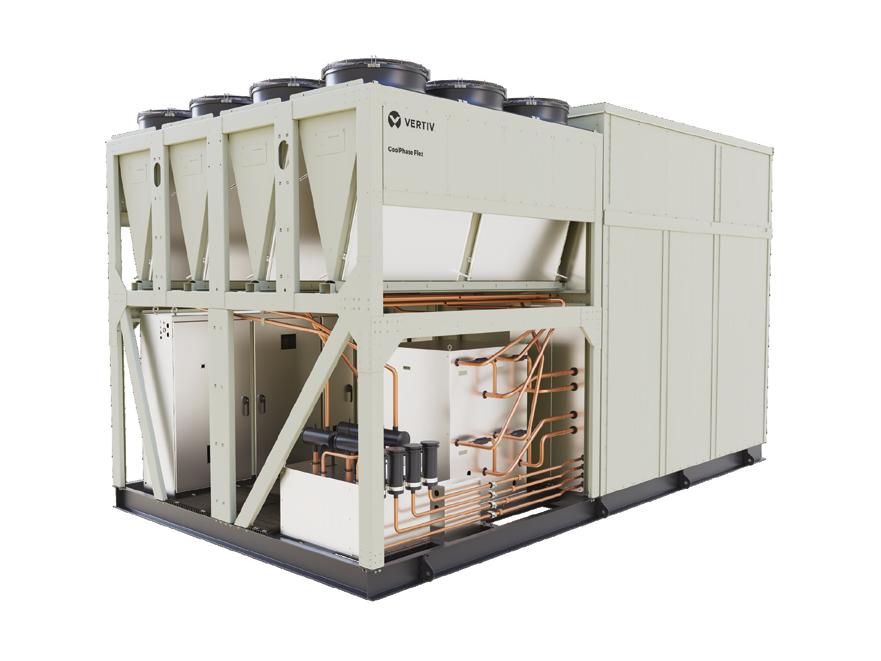
Contents
4. Making a [nano] material difference to data center cooling How nanofluids can improve cooling efficiency, even in legacy cooling systems
10. Could plasma cooling have a place in the data center?
YPlasma and others look to swap server fans for plasma actuators
12. Joule in the crown US firm AirJoule says its water harvesting technology could cut cooling costs at data centers
14. You’re as cold as ice: Antifreeze in liquid cooling systems The importance of stopping things from freezing to keep things moving
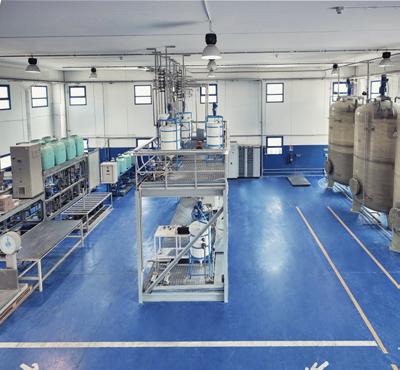


Chilling innovations
Keeping servers at a temperature where they can run efficiently in the age of artificial intelligence is a challenge for many data center operators.
While the AI revolution has heralded the dawn of the liquid cooling era, older technologies remain vital to the operation of many data centers, and vendors are busy finding ways to innovate and commercialize ideas that have been doing the rounds for years.
In this supplement, Georgia Butler finds out how one company, HTMS, is bringing nanofluids into the cooling mix.
Based on a research initiative that started more than 15 years ago at the Università del Salento in Lecce, Italy, the HTMS cooling solutions insert nanoparticles into cooling fluid.
These are ultrafine, tiny particles that measure between one and 100 nanometers in diameter. In the case of HTMS’s “Maxwell” solution, the particles are made of aluminum oxide, and the company believes there are big efficiency gains to be had in pumping them around server rooms.
Meanwhile, experiments around using plasma to cool semiconductors have been carried around the world since the 1990s. Now a Spanish company, YPlasma, wants to take the idea from the theoretical to the practical, with a system that can be used to chill laptop components, and that could eventually be applied in servers too.
YPlasma’s system uses plasma actuators, which it says allow for
precise control of ionic air flow. Dan Swinhoe spoke to the company about how this works, and its plans for the future, which involve finding a partner firm to help bring the system to the server hall.
Over in the US, another technology vendor, AirJoule, is seeking to help make data centers more efficient by harvesting water contained in waste heat. The company has found a way to harness metal organic frameworks, or MOFs, another technology that has thus far been confined to the lab for a variety of technical and economic reasons.
With the backing of power technology firm GE Vernova, AirJoule has built a demonstrator unit that it believes can harvest serious amounts of water. The task for the company is to convince data center operators to take the plunge and install it at their facilities.
AirJoule is targeting data centers in hot environments, where the threat of frozen pipes is probably not something that keeps data centers managers up at night.
For those running facilities in cooler surroundings, a big freeze can have big implications, which is why antifreeze remains a critical part of the data center ecosystem.
Most antifreezes on the market are based on glycol, but its high toxicity means some companies are looking to alternatives, with nitrogen emerging as a potential gamechanger. With more pipework than ever filling the newest generation data centers, keeping the cooling fluid flowing has never been more important.
Making a [nano] material difference to data center cooling
How nanofluids can improve cooling efficiency, even in legacy cooling systems

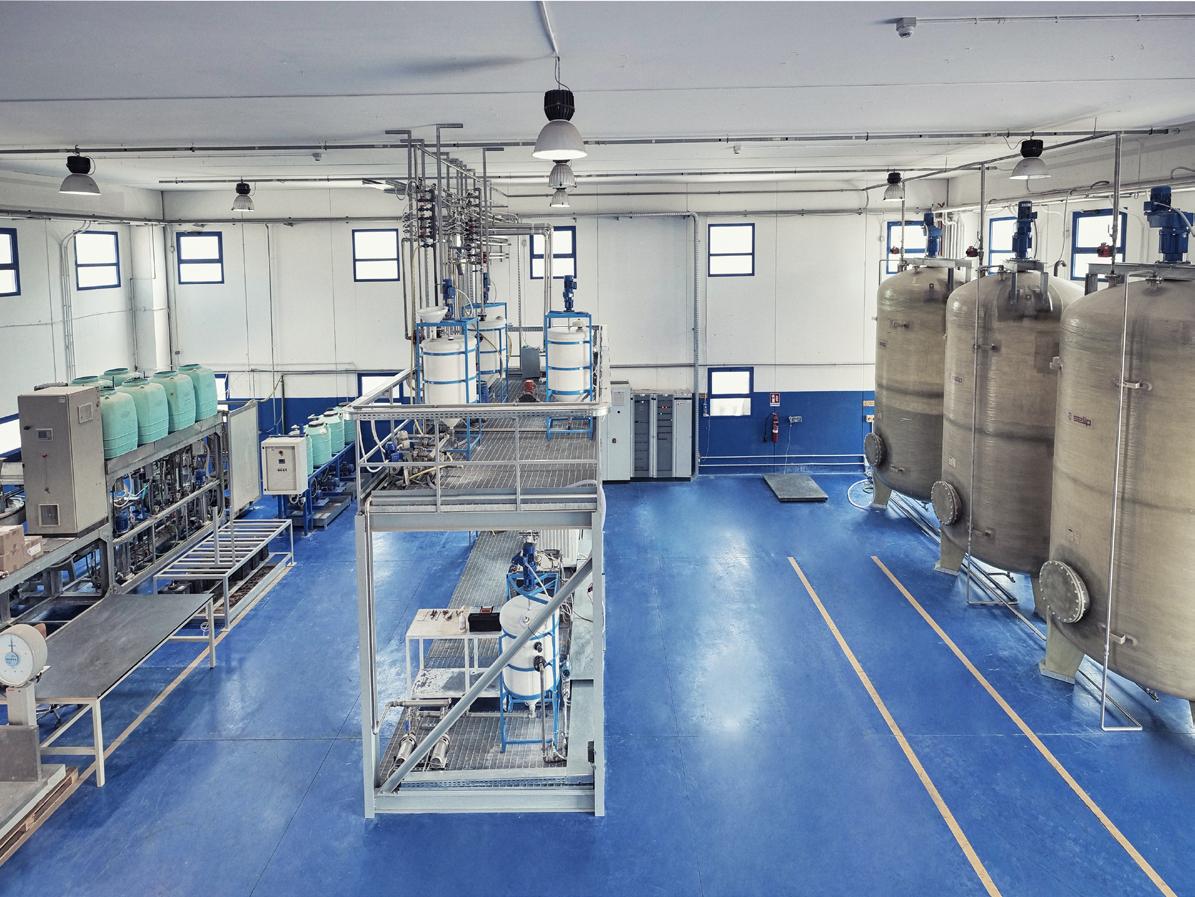
Georgia Butler Senior Reporter, Cloud & Hybrid
Attend any data center conference, and you will find a plethora of new cooling solutions designed to meet the needs of the latest and greatest technologies.
At around 700W and beyond, air cooling for chips becomes increasingly difficult, and liquid-cooling becomes the only realistic option.
Nvidia’s H100 GPUs scale up to a thermal design point (TDP) of 700W, and its Blackwell GPUs can currently operate at up to 1,200W. The company’s recently announced Blackwell Ultra, also known as GB300, is set to operate at a 1,400W TDP, while AMD’s MI355X operates at a TDP of 1,100W.
Recently, liquid cooling firm Accelsius conducted a test to show it could cool chips up to 4,500 watts. Accelsius claims it could have gone even higher but was limited by its test infrastructure, rather than the cooling system itself.
But the reality is that, while much of the excitement and drama in the sector focuses on the needs of AI hardware, the majority of workloads in data centers are not running on these powerful GPUs. The density of these racks is also creeping up, if not to the same level, and many companies are not willing to fully ripand-replace cooling systems in costly and complex programs.
While many companies are looking to reinvent the wheel with flashy new cooling set-ups, a large cohort of data center operators are focused on refining their existing systems, looking to unlock additional efficiencies wherever possible and improve their cooling capabilities at a rate that is appropriate for their needs.
One way of doing this is to optimize the fluid used in existing cooling systems.
Nanoscale changes
A large portion of “air cooling” solutions still use liquid at some point in the system - usually water or a glycol-water mix. When it comes to the choice of fluid, water is typically considered more efficient at transferring heat, but water-glycol can be more suitable when freeze protection is needed.
But, regardless of whether it is a water or a glycol-mix base, Irish firm HT Materials Science (HTMS) says that it can

make your system more efficient with “nanoparticles.”
HTMS was founded in 2018 by Tom Grizzetti, Arturo de Risi, and Rudy Holesek
According to Grizetti, the company’s Maxwell solution stems from a research initiative that started more than 15 years ago at the Università del Salento in Lecce, Italy.
The team was exploring how nanotechnology could be used to fundamentally improve heat transfer in fluid systems. Grizetti says of that time: “It’s one of those rare startup scenarios where deep science meets a real-world market need at just the right moment.”
To date, HTMS’s customer base hasn’t primarily been data centers, with its solution currently deployed at industrial sites and Amazon fulfillment centers, but the company is targeting the sector and talking to operators because, it says, it can see a strong use case.
Nanoparticles are ultrafine, tiny particles In the case of HTMS’s “Maxwell” solution, these particles are over 100 nanometers in size and made of aluminum oxide.
“Our product is a simple fluid additive that goes into any closed-loop hydraulic system, whether that be air-cooled chillers or the vapor side of water-cooling chillers,” Ben Taylor, SVP of sales and business development at HTMS, explains.
Taylor makes the bold claim that Maxwell will improve efficiency at “every heat exchanger in the loop - whether it be the evaporator, barrel, chiller, the coil, or the air handler - they all see better heat transfer capabilities.”
Aluminum is well known for its heat transfer properties. The metal alone has a
thermal conductivity of approximately 237 W/mK (Watts per meter per Kelvin), and the aluminum oxide compound (also known as alumina) has a relatively high thermal conductivity for a ceramic material, typically around 30 W/mK.
While having a lower thermal conductivity than pure aluminum, alumina is more suited to cooling systems as it has greater stability and durability, meaning it works well in high-temperature and high-pressure applications, and provides better corrosion resistance. All of which has been backed up by several scientific studies, including the paper 'Experimental study of cooling characteristics of water-based alumina nanofluid in a minichannel heat sink, published in the Case Studies in Thermal Engineering journal.
The fact is that although alumina is a well-established additive for thermal conductivity solutions, it isn’t widely adopted by the data center industry. While at the Yotta conference in Vegas in 2024, DCD met with HTMS and asked about competition in the industry - only to be told that, currently, they aren’t really facing any.
The nanoparticle solution can be injected into new and old cooling systems, Taylor says, “You get more efficiency in your system, and even if it's an older system, you can start to do more than you thought you could,” he says.
For many data center operators, this is music to their ears. Ripping out and replacing cooling systems costs time and money, but with the growing cooling needs of hardware and increasing regulatory pressures in many markets, finding efficiencies is paramount.
There are, of course, upfront costs associated with the installation of the heat-transfer fluids, but HTMS estimates that companies see payback on this within three years, and some in as little as one year.
Efficiency and environmental impact
From the perspective of sustainability, Taylor says that Maxwell’s carbon footprint is low. “A lot of customers will break even on CO2 emissions within the one to threemonth mark,” he says.
“We are seeing existing systems that
“You get more efficiency in your system, and even if it's an older system, you can start to do more than you thought you could” >>Ben Taylor
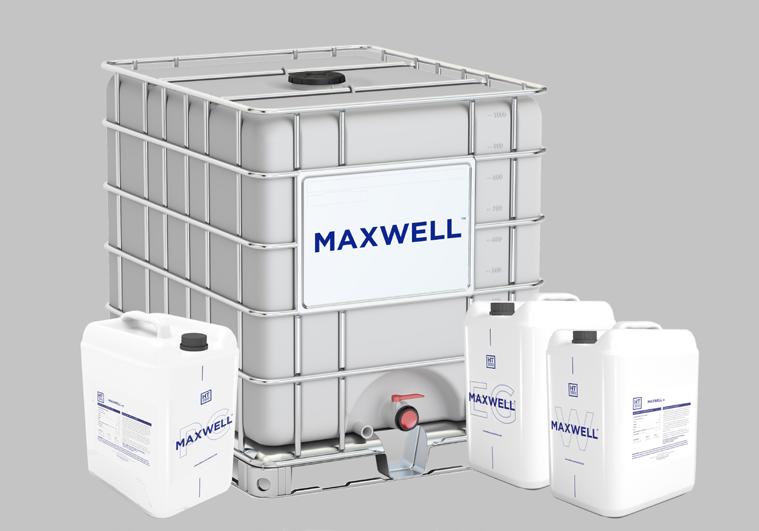
need more capacity, and new systems that are trying to be as efficient as possible because a lot of them are going to start taking up a lot of the power grid - and plenty are already using a lot of power.
“They are looking for a more overall energy efficient system, and one option could be a water-cooled chiller set up with open cell cooling towers. But, while they are more energy efficient, they are costly in terms of water consumption,” he explains, adding that Maxwell can only be used in a closed-loop system.
He continues: “The additives are nanoparticles, so if they are open to the environment, especially in an open cell cooling tower, they could just blow away in the wind.
“The other reason is we have a pH requirement. We normally stay around 10 to 10.5, which is pretty standard in a glycol system, but it is a little higher than you would expect in a water system. And if they are open to the atmosphere, the pH will just keep dropping.”
The improvements seen in cooling abilities vary depending on whether the customer uses water or a glycol mix.
When Maxwell is injected into the
system at a two percent concentration, Taylor says that a water-only system can see around a 15 percent increase in heat transfer abilities, and then with a mix of around 30 to 40 percent glycol, that 2 percent concentration can improve heat transfer capability by as much as 26 percent.
Deploying Maxwell is a simple process, Taylor says. “We have everything preblended and then inject it into a system,” he says. “We need the pumps to be running, unless we are filling the system right out of the gate.”
HTMS usually recommends also installing a “make-up and maintenance unit” (MMU) on the site - a device which monitors the system and maintains the appropriate chemistry and mixture of particles.
Jim McEnteggart, HTMS’ senior vice president of applications, explains: “We usually ship at around 15 percent volume. It’s a liquid, and we then pump it through the system through connections typically on the discharge side of their normal pumps.
“The concentrated products mix with their system, and then we train it
out on the suction side of the pump. There, the MMU has instrumentation that measures the pH and density. When it reaches its target, we know we have enough nanoparticles in the solution to achieve the desired outcome, and we stop injecting.”
McEnteggart adds that HTMS assumes around a “five percent leaking rate per year” according to ASHRAE standards, but that once Maxwell is in a system, the company says it can last for ten years.
“In reality, everything in the loop won’t degrade the aluminum oxide since it’s chemically inert,” McEnteggart says. “So, unless there’s a leak, the product can stay in there for the life of the system.”
That chemical inertia is also a positive factor in terms of the impact - or lack thereof - that the solution could have on the environment if there were a leak.
“It’s not toxic,” says McEnteggart, though he jokingly adds: “I still wouldn’t recommend drinking it.”
“If it got into the groundwater, aluminum oxide by itself is a stable element that's not really reactive with many things. But again, the protocol is that we don’t want it discharged into sewer
“If we lower the pH into the acidic rangeso, below seven - the particles drop out of suspension.”
>>Jim McEnteggart
systems or things like that, because at the concentrations we are dealing with, it could overload those systems and cause them not to work as well as they should.”
This is important to note, as additives can sometimes be PFAs - per or polyfluoroalkyl substances, also known as “forever chemicals”. The nanofluids, while considered an additive, do not fall into this category.
Should a customer want to remove Maxwell from its system - which McEnteggart assures DCD none so far have - it’s a combination of mechanical filtration and chemical separation.
“If we lower the pH into the acidic range - so, below seven - the particles drop out of suspension. They settle very quickly, and we can do that on site, just pump the system out into tanks and add an acidic compound to get the particles to collect at the bottom of the tank.
“We extract from there, and then everything else gets caught by a ceramic filter with very fine pores. Then we neutralize the solution, and if it's water, it can go down the drain, or if it's glycol, it goes to a treatment facility.”
Alumina, and nanofluids by extension, have not sparked much conversation in the industry thus far.
As a result of this, it occurred to DCD that there may be some issues in providing the solution en masse should the industry show significant interest.
“We would definitely have to scale up very quickly,” concedes Taylor. “But a good thing is that the way the product is made is quite a simple approach. Once we see interest growing, we can forecast that, and all we’d have to do is open up a building and get two or three specific pieces of
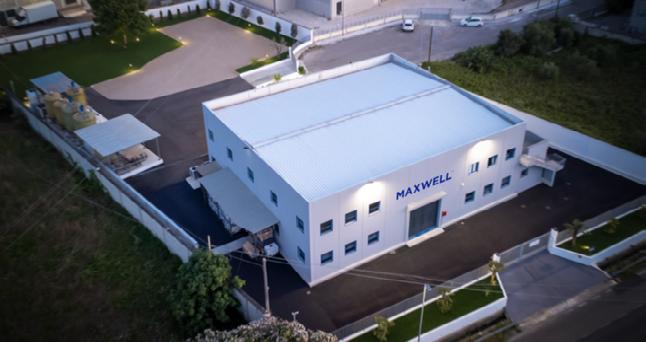
equipment.
“The only limiting factor would really be the raw material suppliers - for the alumina and, in the future, for the graphene. If we hit snags on that end of things, it would be out of our control.”
HTMS has at least one data center deployment that they have shared in a case study, though the company remains anonymous beyond noting the facility is located in Italy. The likes of Stack, Aruba, TIM, Data4, Equinix, Digital Realty, OVH, and CyrusOne, as well as supercomputing labs and enterprises, operate facilities across Italy.
While unable to share identifying details
about the Italian deployment, the total power of the chiller system was 4,143 kW (1.178 RT) and consisted of three chillers and one trigeneration system. According to the case study, the data center saw a system coefficient of performance improvement of 9.76 percent.
But a big part of the challenge when entering a long-secretive industry is getting your name out there if clients won’t let you share their story.
“A lot of them [data center operators] are pretty sensitive about having their names out there,” admits Taylor, though the company remains hopeful that it will fully conquer the data center frontier.
FUTURE POSSIBILITIES
Onthe AI side of workloads, HTMS is currently working behind the scenes on a solution that could work with direct-to-chip cooling solutions.
Direct-to-chip (DTC) brings liquid coolants directly to the CPU and GPUs via a cold plate. The solution is becoming increasingly popular due to its ability to meet the cooling demands of the more powerful AI chips.
Details about the new product are sparse, though Taylor describes it as “more of a graphene-based solution.”
He adds that the data center and chip companies HTMS is currently in discussions with have said that if they
can make a solution that improves the performance of the chip stack by between 4-5 percent, they’ll be “very, very, interested,” but that HTMS is targeting a 10 percent improvement.
Beyond that, the little that can be shared is that HTMS is currently talking with “some of the glycol and heat transfer fluid OEMs that are already dedicated to the DTC cooling space” to see if, down the road, they could offer some pre-blended mixtures.
At the time of talking with DCD, HTMS had “almost done complete iterations in R&D,” but had no further updates at the time of publication.
Solving the puzzle of AI-driven thermal challenges
Thanks to increased power demands brought about by the rapid adoption of AI, data centers are heating up. Delivering flexible, future-ready cooling solutions is now essential
The data center landscape is undergoing a seismic shift. AI, with its immense processing requirements and dynamic workloads, is redefining thermal expectations across the industry. As rack densities climb and traditional infrastructure strains under new pressures, cooling has emerged as one of the most critical and complex challenges to solve.
But just like solving a puzzle, creating an effective data center suitable for growing densities in the AI age isn't about one single component – it’s about fitting the right pieces together.
Providing operators with the tools they need to keep cool under the pressures of increased power demand, Vertiv is delivering future-ready thermal solutions designed to support AI workloads and beyond.
Jaclyn Schmidt, global service offering manager for liquid cooling and high density at Vertiv shares how the company is addressing cooling challenges of today and the future, with innovative, flexible products and services, delivered with an end-to-end, customer first approach.
The thermal puzzle that AI presents
The rise of AI has introduced a level of unpredictability previously unprecedented in data center operations. Huge workloads fluctuate rapidly, often creating thermal spikes that traditional systems struggle to manage. Schmidt compares this unpredictability to the AI market itself:
“AI workloads are just like the AI landscape – constantly shifting, evolving, and difficult to predict. Just as we can’t always foresee where the next breakthrough will come, we also can't anticipate where or when thermal spikes will occur. That’s why flexible and scalable cooling solutions are so essential.”
This demand for agility has pushed the boundaries of what was once considered future-ready. Facilities designed with the future in mind just a few years ago are already being outpaced by the speed of technological change.
“We’re seeing customers who built with scalability in mind suddenly find themselves needing to retrofit or redesign. The pace of innovation is relentless, and infrastructure must evolve just as quickly,” adds Schmidt.
Beyond the box: A system-level approach
Rather than offering isolated cooling products, Vertiv takes a holistic, systemlevel view of thermal management –from chip to heat reuse, airflow to power infrastructure, and everything in between. It's an approach rooted in evaluating how every piece of the puzzle connects.
“This isn’t just about placing one box inside another,” explains Schmidt. “We examine how each component affects the entire system – controls, monitoring, airflow, and more. Everything must work in harmony with efficiency and effectiveness.”
With this comprehensive lens, Vertiv has created a suite of solutions purposebuilt for AI-era data centers. The Vertiv CoolPhase Flex and Vertiv CoolLoop Trim Cooler, for instance, are specifically engineered to handle the heat loads and fluctuating demands of liquid cooling deployments.
“We’ve taken our history with both direct expansion and chilled water systems, and evolved them to meet the needs of AI and hybrid cooling,” says Schmidt. “Products like the Vertiv CoolLoop Trim Cooler
can support mass densification of the data center while also increasing system efficiency without increasing footprint, while the Vertiv CoolPhase Flex enables future-ready modularity – allowing you to switch between air and liquid cooling as your needs evolve over time.”
These options provide operators with unmatched flexibility. Whether there’s a need for direct expansion (DX), chilled water systems, or a hybrid setup that supports mixed workloads and temperatures, access to diverse solutions that address specific, personalized requirements is vital for supporting scalability across the industry.
But it’s not just about connecting indoor cooling units with outdoor heat rejection capability. Having integrated networks of products that work together and constantly communicate to provide a high level of system visibility and control is becoming vital for long-term success. Vertiv has innovated their controls and monitoring platforms to look at the data center as a whole, rather than as individual components, with products like Vertiv Unify.
Tailoring cooling solutions to unique customer demands is an essential part of effective deployments. Each element of Vertiv’s product portfolio is designed to meet customers where they are – whether they’re just beginning to explore liquid cooling or already operating dense, AIheavy environments.
“One of the misconceptions is that if you’re deploying liquid cooling, you must use chilled water,” explains Schmidt. “But that’s not always true; it’s highly dependent on the challenges you’re trying to solve. We’ve developed solutions like the Vertiv CoolPhase Flex and Vertiv CoolPhase CDU to offer adaptable alternatives – modular, scalable tools that grow with the needs of the data center.”
By offering flexible solutions that can evolve without replacing entire systems, Vertiv helps operators plan with confidence, knowing today’s decisions won’t limit tomorrow’s potential.
Providing the right tools
Collaboration and communication between providers and operators is vital for developing innovative, resilient solutions that tackle the real day-to-day challenges. At the heart of Vertiv’s approach is a
commitment to co-creation. Rather than simply delivering products, the company works alongside customers to define the right journey, from early design consultation through to deployment and ongoing maintenance. Schmidt explains:
“We don’t believe in a one-size-fits-all approach. We ask: What are your specific challenges? Are you midway through a transition or starting from scratch? We help define a path forward based on those answers.”
That path includes expert services throughout the entire lifecycle. With approximately 4,000 service engineers and over 310 service centers worldwide, Vertiv aims to make sure that local support is never far away.
“If something goes wrong or customers need help, we’ve got boots on the ground, anywhere in the world,” she says. “That level of regional expertise allows for smoother integration, better response times, and peace of mind for our customers.”
Every data center is unique. Whether it's a retrofit or a new build, successfully transitioning to liquid cooling, or optimizing hybrid models to manage thermal challenges, requires a strong focus on sustainability, energy efficiency, and minimizing disruption for both implementation and long-term operation.
Schmidt explains the unique challenges associated with retrofit projects: “Retrofitting is like decoding someone else’s design puzzle. You have to figure out what can stay, what needs to change, and how to integrate new pieces without disrupting operations. We offer creative, consultative advice to make that possible.”
That includes services like recycling, repurposing, and refurbishing existing equipment – not just to reduce waste, but to extend the life of investments, lower costs, and improve operational continuity.
Research, innovation and the road ahead
Vertiv’s research and development (R&D) efforts are fueled by a dual engine: realworld customer feedback and forwardlooking market analysis. This two-pronged approach enables continuous development across the liquid cooling spectrum, including direct-to-chip, immersion, and two-phase technologies.
“We’re not betting on one technology,” explains Schmidt. “We’re exploring everything from single-phase immersion to two-phase liquid cooling to meet niche and emerging needs. That diversity means we can be ready for whatever comes next.”
Crucially, this innovation is always tied to real customer pain points: “We’re constantly collecting feedback and asking: What else do our customers need? What aren’t they seeing yet? Then we build products and services to address those gaps,” she says.
This ongoing iteration makes Vertiv more than a vendor, positioning the company as a true partner in problemsolving, empowering operators to drive the vision for their own data center designs while providing the tools for success.
Although attempting to predict what the future may hold is perhaps the greatest challenge for the industry, some things are certain: workloads will continue to grow, densities will rise, and Edge deployments will proliferate. Meanwhile, regulations, chip designs, and sustainability requirements will keep evolving in response.
“We’re constantly tracking the shifts – whether it’s Edge computing, modular builds, or ultra-high-density racks,” says Schmidt. “Each one requires a different strategy, and we’re committed to staying ahead with innovation and responsive service offerings.”
With a modular, scalable, and consultative approach, Vertiv is giving customers what they need to build, both now and in the future – meaning that as the data center puzzle grows more complex, they’ll always have the right pieces in hand.
In a world shaped by AI, flexibility and foresight are no longer optional –they’re essential. Supporting operators in designing, building, and maintaining cooling systems that aren’t just solutions for today’s thermal challenges, but can adapt to support future demand, is key to piecing it together.
Learn more about Vertiv’s liquid cooling solutions here.
Could plasma cooling have a place in the data center?
YPlasma and others look to swap server fans for plasma actuators

Dan Swinhoe Managing Editor, DCD
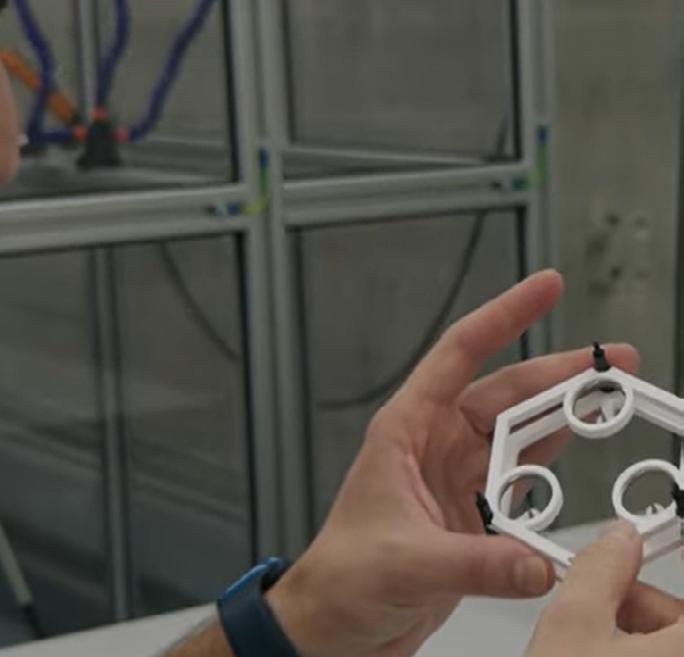
Though the data center industry is currently focused on directto-chip liquid cooling, most of the world is still air-cooled. Thousands upon thousands of servers remain equipped with fans blowing air away from CPUs.
And though bleeding-edge GPUs have reached the point where air cooling is no longer feasible, air cooling is still the norm for many lower-density workloads and will continue to be so for years to come.
Spanish startup YPlasma is looking to offer a replacement for fans inside servers that could give air-cooling an efficiency and reliability boost. The technology essentially uses electrostatic fields to convert electrical current into airflow.
Launched in 2024, the company was spun out of the National Institute for Aerospace Technology (Instituto Nacional de Técnica Aeroespacial, or INTA) – the Spanish space agency part of the Ministry of Defence and described by YPlasma CEO David Garcia as Spain’s NASA.
The Madrid-based company’s technology uses plasma actuators, which it says allow for precise control of ionic air
flow. Though interest in plasma actuators dates back to the days of the Cold War, they first left the lab in 1990s, being used to improve aerodynamics.
The company’s actuator is called a Dielectric Barrier Discharge (DBD) and composed of two thin copper electrode strips, with one surrounded by a dialectric material such as Teflon. The actuators can be between just 2-4 mm thick.
When you apply high voltage, the air around the actuator ionizes, creating plasma just above the dialectric surface. This can produce a controllable laminar airflow of charged particles known as ionic wind that can be used to blow cold air across electronics.
The direction and speed can be controlled by changing the voltage going through the electrodes. Garcia says the actuator’s ionic wind can reach speeds up to 40km per hour, or around 10 meters per second.
INTA’s technology was originally developed for aerodynamic purposes, with YPlasma initially targeting wind turbines. The actuators can be used to push air more uniformly over the turbine
blades, producing more energy.
In the IT space, the company is looking at using its actuators to force air across chips, removing the need for fans –potentially saving space and power, offering greater reliability than fans, and removing vibrations, which could increase hardware lifespans. The company says its DBD actuators can match or exceed the heat dissipation capabilities of small fans.
This ionic wind, the company says, also removes the boundary layer air on electronics, allowing for better heat dissipation, resulting in natural heat convection combined with the forced convection of airflow over the chips. The cooling, it claims, can also be more uniform, eliminating hotspots.
YPlasma is currently working with Intel and Lenovo to look at using its plasma technology in laptops and workstations, but thinks there could also be utility within the server space.
Intel has been exploring ionic wind in chip cooling since at least 2007, previously partnering with Purdue University in Indiana; the chip giant has previously filed patents for a plasma cooling heat sink that would use plasma-driven gas flow to cool down electronic devices.
“We were curious if we were able to provide cooling capacity to the semiconductor industry,” says Garcia. “So we engaged with Intel; Intel has been doing research on plasma cooling, or ionic wind, for some years, so we were speaking the same language, and they asked if we could develop an actuator for laptop applications to cool down a CPU.”
“We started working with Intel in August (2024), and we developed a final prototype in January,” he adds. “In May or June, we will be ready to implement them in real laptops.”
Now YPlasma is looking for a project partner to begin developing and proving out server-based products. Garcia has “been in conversations” with potential collaborators but is yet to secure a project partner.
“We've been exploring this space, and realizing that every single week we are able to pull down much higher demand in applications,” he continues. “We've seen that we can get higher levels of heat dissipation. And our objective is to evaluate if this technology is able to help on the data center industry. Perhaps not in the most demand applications where liquid cooling is necessary, but there’s some intermediate
applications where we can replace fans.”
In a talk at the OCP EMEA Summit in Dublin in April, YPlasma presented its aims in the data center space, saying it has been collaborating with “one of the main companies in the semiconductor industry” and that so far “all expectations have been exceeded,” with the system showing better performance than a regular cooling fan.
In early tests, the company says its actuators have been able to match or exceed the cooling performance of an 80 mm fan under a 10W heat load. The actuators can also work below 0.05W, requiring less power than a fan to operate. A test video on the company’s website shows a chip being cooled from 84°C (183.2°F) down to 49°C (120.2°F).
As well as general cooling benefits, YPlasma claims its technology comes with added bonuses for data center firms. The company says plasma coatings can provide a barrier against corrosion and oxidation, protecting components from humidity and other environmental contaminants in high humidity or industrial environments where equipment is more exposed to harsh conditions. Plasma, it adds, can effectively remove contaminants such as dust, oils, and organic residues without physical contact or harsh chemical products; dusty and dirty Edge deployments such as mining or factories could benefit from fewer fans and cleaner air running through the systems.
Beyond the servers themselves, YPlasma thinks its technology could have application within the HVAC system. By ionizing the gas inside the heat exchangers, you could enhance the heat transfer coefficient.
The system can also produce heat instead of cold air, which could be used as a type of antifreeze; Garcia says it can generate heat up to 300°C (572°F).
And another potential use, the company suggests, is to create plasma-activated water, which can have better heat transfer coefficient than regular water in liquid cooling systems. Research is still going on in this field.
In the future, the company said it will be possible to combine actuators with AI algorithms, making it possible to optimize airflow control in real-time, automatically adapting to changing conditions.
Investors in YPlasma include SOSV/ HAX
“We were curious if we were able to provide cooling capacity to the semiconductor industry”

and Esade Ban, which both contributed to seed rounds totaling €1.1m ($1.2m) in 2024. Other investors include MWC’s Collider, and the European Space Agency’s Commercialisation Gateway. Garcia was previously CEO of Quimera Energy Efficiency, a company that uses software to reduce energy demand in the hospitality sector; and immersive virtual reality firm Kiin. He says the company has recently closed another €2.5 million ($2.8m) raise.
Though Intel has been exploring the space for years, it isn’t the only company to have looked at plasma-based cooling for electronics over the years. Apple filed a patent for an ionic wind cooling system back in 2012, but it's unclear if the company ever took the idea further. Tessera, a chip packing company later renamed and broken out into Xperi Inc. and Adeia, demonstrated ionic wind cooling for a laptop in 2008 alongside the University of Washington.
YPlasma is not the only company that is looking at plasma for cooling today, and there could be a race to commercialize the technology. Ionic Wind Technologies, a spin-out from the Swiss Federal Laboratories for Materials Science and Technology (Empa), is also looking at developing its own ionic wind amplifier that could be used for chip cooling.

A bigger product than YPlasma’s and developed as a way to dry fruit, the company claims its custom-made needle tip electrodes achieve up to twice the airflow speeds compared to conventional electrodes and use less energy. The spin-off funding program Venture Kick and the Gebert Rüf Stiftung are providing financial support to the Empa spin-off as part of the InnoBooster program to bring the product to market maturity.
“We produce the airflow amplifiers ourselves and want to sell components in the future. However, as we have patents and other ideas, a licensing model could also be conceivable,” Ionic Wind founder Donato Rubinetti said in the company’s early 2025 launch announcement. “I see the potential wherever air needs to be moved with a small pressure difference. In future, however, above all in the cooling of computers, servers, or data centers.”
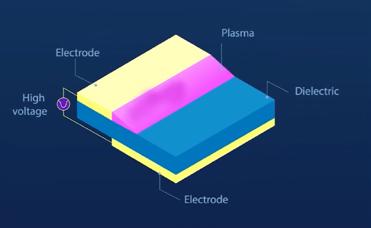
In the meantime, YPlasma’s Garcia says once the company finds a server-centric partner to collaborate with, it could have a working prototype on a specific application within six months.
“We just need to understand what the requirements are that we want to achieve,” he says. “It's easy to build; we’ve got a lot of experience testing this.”
While it could be beneficial in some scenarios, the company does concede that its technology won’t be applicable to all chips within a data center. It is not, for example, aiming to compete with the densities liquid cooling is designed to cool, but can help remove fans in some aircooled applications.
“We’re never going to have the capacity to remove as much heat as liquid or immersion cooling,” says Garcia, “but I think there’s a lot of heat we can remove without those technologies.

David Garcia
Joule in the crown

US firm AirJoule says its water harvesting technology could cut cooling costs at data centers
China has a lot of electric buses. In 2023, the nation’s public transport network was home to more than 470,000 electric vehicles ferrying passengers to and from their destinations.
These buses provided an unlikely inspiration for AirJoule, a firm seeking to cut data center emissions with a system that can capture water from waste heat generated at air-cooled data centers so that it can be reused.
“One of my previous companies worked with [Chinese battery manufacturer] CATL to marry our motor technology with their batteries,” says AirJoule CEO Matt Jore. “We developed an advanced power train which is operating in buses all over China.
“As part of that process we discovered that in congested cities, where 90 percent of the journey is spent in traffic stopping and starting, air conditioning is blasting away, so it’s not unheard of to have seven or eight times more energy drain from the battery for air conditioning than in normal driving conditions.
“So we started looking at ways to
improve the efficiency of that air conditioning, and that’s what got me involved in what we’re doing now with AirJoule.”
AirJoule’s system will not be taking a ride on the bus anytime soon, but the company intends for it to become a common sight in heat-generating industrial settings such as data centers, where it says it could help cut energy usage.
Organic growth
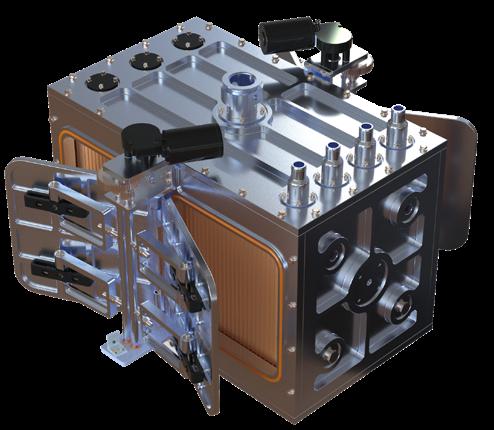
AirJoule’s machine is based on metalorganic frameworks, or MOFs, a type of porous polymer with strong binding properties and a large surface area. This, in theory, makes MOFs ideal for binding onto specific particles, such as water.
MOFs have been around for years, Jore says, but applying them in commercial settings has been difficult for two reasons; activating the useful properties of the polymer generates heat, and the material has been expensive to produce and purchase.
“We can reduce the amount of power needed in data centers by accessing the world’s largest aquifer - the atmosphere”
>> Matt Jore
AirJoule solved the price issue by working with chemical company BASF to develop a cheaper MOF. By scaling the production process, Jore claims the company has managed to reduce the cost of the material from around $5,000 per kg to “something nearer $50.” When it comes to the first problem, AirJoule’s system reuses the heat generated by the MOF to turn water vapour back into liquid, creating what the company says is a “thermally neutral” process.
Explaining how the system works, Jore says warm air enters the AirJoule machine and is processed in two stages. “We divide the water uptake and the water release into two chambers that are performing their functions simultaneously,” he says. “The heat generated in the absorption process is passed over to the second chamber, and it’s pulled under a vacuum. We suck the air out, and now all that remains is this coated material full of water vapor molecules.”
Matthew Gooding Senior Editor
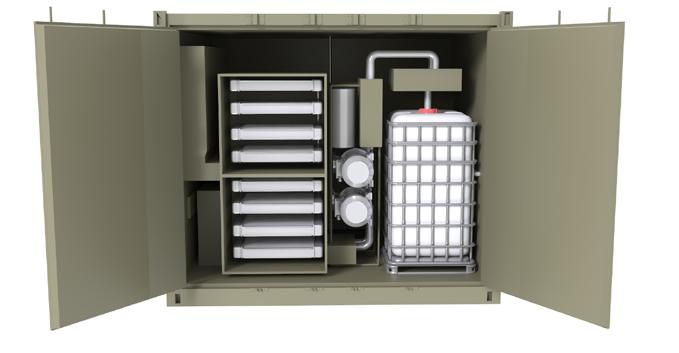
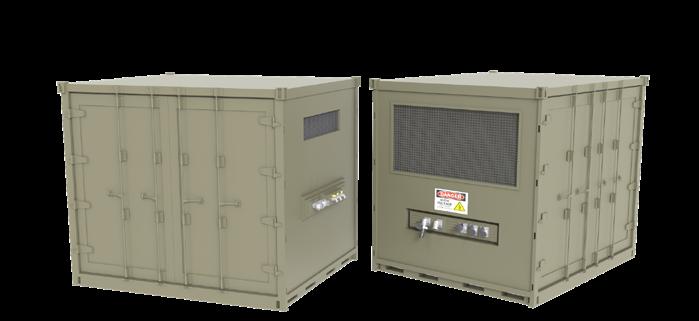
The system then initiates its vacuum swing compressor that “creates a pull on the water vapor molecules,” Jore says. “Trillions of these molecules pass through this vacuum swing compressor, and we slightly pressurize them so that they increase their temperature and condense.”
How much water comes out at the end of the process depends on how many AirJoule systems you buy. The company says one module will be able to harvest 1,000 liters of distilled water a day, either to be reused by the data center’s cooling system or supplied to the local community. “You can scale it in modular pieces,” Jore says.
Despite the claims of thermal neutrality, AirJoule does still produce a small amount of waste heat. In March, the company revealed that tests had shown that AirJoule demonstrated the ability to produce pure distilled water from air with an energy requirement of less than 160 watt-hours per liter (Wh/L) of water.
This apparently makes it more efficient than other methods of extracting water from air. “Compared to existing technologies, AirJoule is up to four times more efficient at separating water from air than refrigerant-based systems (400-700 Wh/L) and up to eight times more efficient than desiccant-based systems (more than 1,300 Wh/L),” the company said in March.
Building a partnership
The AirJoule machine is based on principles developed by Dr. Pete McGrail at the Pacific Northwest National Laboratory, a US scientific research institution in Richmond, Washington.
After meeting Dr. McGrail during the
“The challenges the world faces around water supply are not going to be solved by any one company”
>> Matt Jore
Covid-19 lockdowns and finding out more about his work, Jore and his colleagues decided to try and turn it into a product. They teamed up with power technology firm GE Vernova, which was already working on its own air-to-water project with the US Department of Defense.
Recalling the early days of the collaboration, Jore says: “The two teams met in Montana in my garage. We had four PhDs from GE Vernova come out and spend the week with us and try to put our technologies together, and by the end of the week, we were clinking beers together because we knew we had something promising.”
To take the technology to market, a joint venture was formed in March 2024 between Jore’s firm, Montana Technologies, and GE Vernova. The partners each own 50 percent of the JV, though in a slightly confusing move, Montana Technologies has since changed its name to AirJoule Technologies Corporation, a decision it took to reflect its role in the JV.
The JV raised $50 million when it went public via a special purchase acquisition company, or SPAC, last year, and in April announced it had raised an additional $15 million from investors, including GE Vernova. So far, it does not appear to be offering great value for its stockholders,
with its share price having dropped significantly this year.
Jore and his team will be hoping to change that when it gets its machines into data centers and other facilities that produce a lot of heat.
“With every business I’ve worked on, you build a prototype, with cost and reliability defined, and get people to come and see it,” he says. “We’re going to have a working unit this year that we can show to our customers and partners, and from there we’ll be able to demonstrate the replicability of that unit.”
He believes the AirJoule offer will be compelling for the market, despite the plethora of water harvesting technologies that already exist.
“The companies that have been out there for the last 20 years using desiccants to absorb are not transferring the heat of absorption like we are,” he says. “We have a unique proposition in that respect.
“But the challenges the world faces around water supply, in the global south and here in the US, in places like Arizona and California, are not going to be solved by any one company, and they’re likely to get worse over the next five years. There are some great people working in this space, and I see a lot of synergies between us. It’s going to take a common heart and a common mission to tackle this problem.”
He adds: “The conversation in the data center industry at the moment is all about power, and we can reduce the amount of power needed by accessing the world’s largest aquifer - the atmosphere. AirJoule is the first technology that makes tapping into that aquifer a truly ethical prospect.”
You’re as cold as ice: Antifreeze in liquid cooling systems

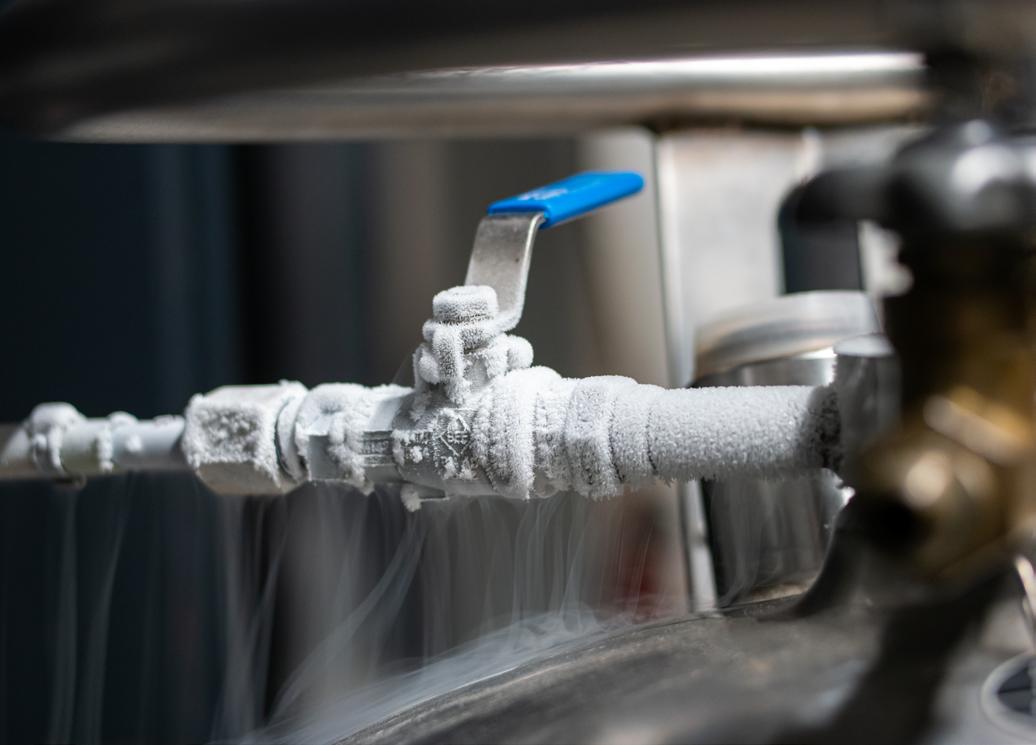
The importance of stopping things from freezing to keep things moving
Liquid cooling has emerged as the data center industry's goto for high-density servers and advanced workloads.
The type of liquid used varies from system to system, but with a much higher heat capacity than any other liquid and impressive thermal conductivity, water makes for an excellent coolant.
However, its downfall is the result of basic physics - water freezes. Frozen pipes are a disaster in any situation, from household plumbing to a car engine or data center cooling systems. But unlike a frozen pipe in a house, when it comes to
a data center’s cooling loop, you cannot simply flush the system with hot water. That’s where antifreeze comes in.
What is the point of antifreeze?
Antifreeze stops the water in the primary loop of a cooling system from freezing should the outdoor temperature become too low. It also plays an important role if servers stop working, preventing water from freezing in the absence of the heat usually provided by the hardware.
“Essentially, antifreeze is glycol,” says Peter Huang, global vice president for data center thermal management at oil company Castrol. “The percentage
of glycol depends on how cold the environment is. The colder the environment, the higher percentage of glycol antifreeze that you need to use.”
In a very cold environment, the percentage of glycol may reach up to 50 percent. In Canada, says Huang, operators are using percentages of up to 40 percent to prevent liquid cooling systems from freezing over. Concentrations aside, there are also different varieties of antifreeze.
The first is propylene glycol (PG), and the second is ethylene glycol (EG). While EG is much more effective when it comes to cooling, it is a toxic chemical with many potentially dangerous side
Niva Yadav Junior Reporter
Octavian Lazar/Getty Images
effects related to exposure. PG is less toxic and more environmentally friendly, but far less efficient as a coolant. This means, Huang argues, that its green credentials are up for debate, as a less effective coolant drives up the amount of electricity used to pump the water around the loop system to cool the chips.
Though traditionally a company focused on lubricants for vehicles, Castrol has been expanding its data center business in recent years, with a range of cooling fluids for different systems, as well as antifreeze. Its products are marketed based on the type of glycol they contain and the concentration, but it is worth noting that the product is not usually shipped as a finished good, Huang explains. To save on both energy costs and shipping costs, glycol is shipped as a concentrate. Once it is received at the data center, it can be blended with water.
Keeping track of the amount of antifreeze in a system is also important, as the liquid cannot simply be left alone. Huang says Castrol recommends its clients take samples every 50 to 100 days, as antifreeze can evaporate, particularly in dry, warm climates. Most of the refills happen in the primary cooling loop, he adds.
Cold and broken
Cooling is a complicated equation, Huang explains, and depends on the chip, the density, and the system as a whole. Cold climates may be branded as a big advantage for the cooling world, says Huang, but they make liquid cooling systems susceptible to freezing.
This is where antifreeze becomes an important part of the picture.
Cold regions such as the Nordics are often hailed as the data center industry’s solution to rapidly growing cooling system power needs. Operators in countries like Norway routinely rave about their sustainability, reduced capex and opex, and improved efficiency, all achieved through free cooling, or using the external air temperature to chill cooling fluid.
In 2024 Montana-based cryptomine data center firm Hydro Hash suffered an outage after temperatures dropped from -6°C to -34°C (21.2°F to -29.2°F) in a little over 24 hours. Its 1MW facility lost power,
“Cold climates may be branded as a big advantage for the cooling world, but they make liquid cooling systems susceptible to freezing”
resulting in the water block cooling system freezing solid.
Castrol’s Huang explains that operators can save a substantial sum by using direct and indirect free cooling, foregoing the need for mechanical chillers. For instance, he says, in Iceland, the ambient temperature averages below 15°C (59°F) and so can be used for free cooling, although he notes that data center operators don’t design facilities that purely use direct free cooling.
And while antifreeze is more necessary in cold climates, data centers operating in more temperate regions still need to consider it an important part of their cooling systems.
Huang says that the most important phrase when designing a cooling system is “supply temperature,” the temperature the cooling fluid needs to be when it reaches the rack to effectively cool the hardware. This can be calculated by working backward. For example, if the customer wants the water temperature inlet reaching the racks to be 26°C (78.8°F), the water in the primary loop needs to be around 20°C (68°F), which means the ambient temperature needs to be around 15°C.
An alternative to antifreeze
As it stands, Huang believes there is no emerging alternative to antifreeze. As
long as water remains the best heatconductive fluid and liquid cooling is necessary in the data center, antifreeze is the only solution to preventing unwanted frosty surprises.
However, LRZ München, the supercomputing center for Munich’s universities and the Bavarian Academy of Sciences and Humanities, has deployed an alternative to glycol-based antifreeze systems, using nitrogen. The university decided to take a new approach to antifreeze in part because of its location adjacent to the River Isar. Glycol is particularly toxic for marine life, meaning a leak into the river could have damaging consequences.
Hiren Gandhi, scientific assistant at LRZ München, explains that the system uses purified water. In comparison to a water and glycol solution, the heat capacity and thermal conductivity of pure water are higher, and the viscosity of the fluid is lower, so less energy is required to pump the liquid around the system. “It’s not a secret,” he says.
“What we have here is a standard chemistry lecture in schools.”
If the ambient temperature reaches freezing point, the water is immediately drained out, and nitrogen is sent through the pipes. Gandhi explains: “If we use air through the pipes, oxygen will corrode them. Therefore, we use nitrogen.”
With the pressure of nitrogen entering the pipes, all water is drained. Gandhi adds that the system is designed “only for an emergency situation,” and is activated when the servers stop working. If the servers are not down, they are able to supply enough heat so that the water never freezes, even in freezing outdoor temperatures.
“The colder the environment, the higher percentage of glycol antifreeze that you need to use”
>> Peter Huang
Gandhi says this has enabled LRZ München to achieve 30-40 percent energy savings. The system could be put to use in larger data centers, he says, as it is easily scalable, though obtaining and storing nitrogen in large quantities is not without its problems.
Whether viable alternatives to glycolbased antifreeze emerge for commercial operators remains to be seen, but with more and more pipe work filling the newest generations of AI data centers, keeping the water flowing has never been more important.
Power-e cient cooling rede ned.
Achieve up to 3 MW capacity with 70% lower power consumption. Designed for AI densification, this adaptable, liquid-ready solution delivers safe, reliable, and energy-e icient performance, meeting

